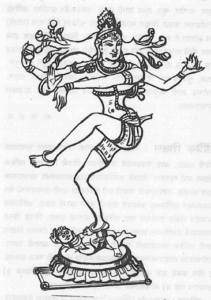‘The Science of Performing Arts’ is the literal translation of the ancient Hindu drama treatise titled ‘Natyashastra’. Written by a sage named Bharat Muni, this book is a comprehensive drama, dance, and music guide. Furthermore, it contains a total of 36 chapters, and 6000 verses of poem. In other words, it is an ‘encyclopedia’ which explains in detail the ‘Indian way’ of performing arts. So, here is presenting few facts, to explain the importance of this classic text, and its connection to the development of Indian Dance Forms.

a. The genesis of Natyashastra:
According to Hindu mythology, ‘Lord Brahma’ was the creator of the ‘Natyashastra’. The story goes that, people on earth during the 1st century BC had become obsessed by greed and lust. It was Lord Indra (God of Lightning, Thunder, Rains and River flows) and few other gods who closely observed this degeneration of the human soul. And therefore, it was out of concern (for mankind) that they requested Lord Brahma to find a solution. To which Brahma said that he had created the ‘Vedas’, to help people understand the importance of good life. However, Indra and the rest immediately reminded him that people belonging to the ‘Sudra Caste’ (lower) were not allowed to read the Vedas. It was then to create a ‘Veda’ which would allow people belonging to all castes to make use of it, that Brahma created this treatise.
b. The ‘involvement’ of Bharat Muni as the author of Natyashastra:
Unfortunately, the ‘Natyashastra’ was found to be extremely difficult to read by Indra and the other gods. It therefore became imperative that this book be written in a language that can be easily grasped by people. And so, a sage named Bharat Muni was given the extremely difficult task of rewriting the text by Brahma. In addition, he also requested Muni to produce a play. It was therefore to improve readability of this treatise, that Bharat was eventually chosen as the author.
c. Lord Shiva’s cosmic dance Tandav, and its relation to Natyashastra:
Apparently once the ‘Natyashastra’ was written, Brahma requested Muni to present a play known as ‘Samavakara’ (one among the ten types mentioned in this book) for Lord Shiva. And so, Bharat accompanied by Brahma and other gods visited Lord Shiva on top of the Himalaya Mountain, and entertained him with a live performance. The play conducted by Muni was so effective, that Shiva was completely floored by the execution. He then explained to Brahma that certain aspects of the play reminded him of the cosmic dance (Tandav) he performs in the evening. Furthermore, he advised Brahma to make more effective use of ‘Karana’s’ (synchronized movements of hands and feet) and ‘angahara’s’ (formed by fusing 7 or more ‘Karana’s) . In reply Brahma, asked him to explain these concepts to Bharat in detail, to which Shiva called Tandu, his attendant to do so. In total, (according to this treatise) the ‘Tandav’ comprises of ‘108’ Karana’s and ’32’ ‘angahara’s’, which eventually forms the foundation stone of all Indian dance forms.
d. The concept of ‘Hastaabhinaya’ mentioned in the Natyashastra:
‘Acting by the hands’ is what literal translation of the concept termed as ‘Hastaabhinaya’, mentioned in chapters 9 and 10 of the Natyashastra. According to the author (Muni), hastaabhinaya for dance comprises of 64 gestures, while acting involves the use of just 24. Furthermore, a gesture according to this text has been termed as a ‘mudra’. In addition, movements of body parts (involved in dance) such as chest, abdomen, hip, and the feet is discussed in great details in this classic Indian performing arts treatise.
e. The study of Music and Musical Instruments in the Natyashastra:
Music is an integral part of any form of performing art, and hence (not surprisingly) has been discussed in great details in chapters 28, 29, 30, 31, 32, and 33 of the Natyashastra. Most of these chapters deal with either the use of musical instruments or vocals. In terms of instruments, as per the text there are four types: avanaddha, stringed instruments, ghana, and susira. They are defined as follows:
- Stringed instruments: Instruments with string. Eg Veena
- Avanaddha: Instruments which are covered. Eg. Drums
- Ghana: Instruments that are solid. Eg. Cymbals
- Susira: Hollow Instruments. Eg. Flutes
Now, there is also a concept discussed in chapter 28 known ‘musical scale’, which comprises of 7 ‘svaras’ (notes) , and they are Sadja (Sa), Rsabha (Ri), Gandhara (Ga), Madhyama (Ma), Pañcama (Pa), Dhaivata (Dha), and Nisada (Ni). Furthermore, information about which scale ideally suits the various forms of performing art is also mentioned in this book.
The fact that great Indian actors such as Nasseruddin Shah and Om Puri have studied the Natyashastra while honing their skills at NSD (National School of Drama), only illustrates the true worth of this brilliant Indian manual on performing arts.
Image Credits: Wikimedia Commons and Wikimedia Commons
